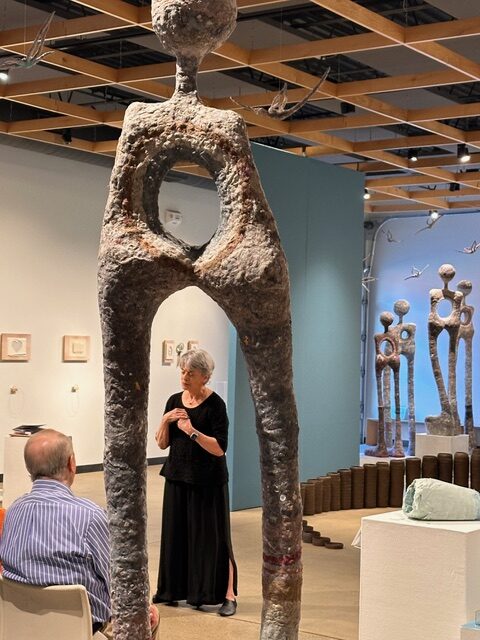 Our perspective is our attitude or way of regarding something. This generally is based on our experiences and the information we have about the topic. Last spring, when I was introduced to some people who were members of a book club, one of the people in the group who knew me suggested that my new book could be one of the books that the club focuses on this season. But as soon as I said the title, The Art of Grieving: How Art and Artmaking Help Us Grieve and Live Our Best Lives, another woman spoke up immediately to object to that idea, and to what she understood my perspective on grief to be. “Grief is horrible. It’s painful, and something you don’t want to focus on,” she asserted. She gave some evidence from her own experience to underscore her point and to make sure the matter was decided in her favor.
Our perspective is our attitude or way of regarding something. This generally is based on our experiences and the information we have about the topic. Last spring, when I was introduced to some people who were members of a book club, one of the people in the group who knew me suggested that my new book could be one of the books that the club focuses on this season. But as soon as I said the title, The Art of Grieving: How Art and Artmaking Help Us Grieve and Live Our Best Lives, another woman spoke up immediately to object to that idea, and to what she understood my perspective on grief to be. “Grief is horrible. It’s painful, and something you don’t want to focus on,” she asserted. She gave some evidence from her own experience to underscore her point and to make sure the matter was decided in her favor.
Fortunately for me, I have given up what used to be my practice –attempting to change a person’s opinion, attitude, or viewpoint on something that my experience has taught me is critically important to our vitality and enjoyment of life. I remind myself that in literature, some characters are not open to growth experiences, and the narrator’s perspective can be classified as naïve or unreliable.
To spend the time to write a whole book on the topic means I am pretty committed to the need to change the perspective on grief that Western Culture has given us. As a grief advocate, I have become fascinated by how the arts cause us to continually change our perspective, not only on the loss of our loved ones, but on how we see ourselves and life itself.
Interacting with the art pieces at the Hereafter art exhibit at Contemporary Craft last weekend in Pittsburgh we were witnessed by people who were at least curious about how grief and art can interact and enlighten. The InterPlay-based troupe, Wing & A Prayer Pittsburgh Players and I brought dance, music, and our stories to respectfully connect with and honor the 13 artists and their explorations of grief, mourning, and the celebration of life.
The six 8 ft high two-legged armless figures by artist Cheryl Capezzuti loomed large in the gallery space. Titled “Bipedal, Heroic IV, 2021” the blueish grey figures were constructed using residential dryer lint. Here are some ways that interacting with this exhibit enhanced my understanding of the relationship of grief and art and how the experience changed me.
- My perspective on reusing and recycling always draws me to art pieces made from materials that are plentiful, overlooked, and undervalued. Dryer lint is the exfoliated material from the fabric we wear when it is washed. This put me in mind of a young woman who, after her father died, comforted herself by wearing his robe. It allowed her to stay close to her father through the scent that it carried. It also caused her to not want to ever wash it.
- In contemplating the bipedal figures, we troupe members decided to accept their limitations as our own and move together in the space between the figures without using our arms. Creativity always happens within limitations, forcing innovation. In the improvisational form, Walk, Stop, Run to connect with one another we could only lean. This seems related to, in the acute stage of grief, how we need to act to accept the reality of the loss while allowing others to comfort us.
- As we move back and forth in the space and stop to look up at the figures their scale overpowers. Our loss is enormous, and we feel very small. In a significant loss, we risk losing ourselves.
- As Jett, the improvisational pianist supports us moving, separately and together, the music carries us to leaning connections and eventually, to stillness. In grief, music ignites our feelings and provides harmony and a resolution of the discord, for now.
- In the performance arts, comments or noticings from the audience whose point of view is broader and wider than our own can add an enlightening perspective. At the end of the presentation one man said, “When I view the figures the most prominent feature is that they have no hearts. Their centers are missing. When you dancers moved between the figures and leaned on one another, it seemed to me that you provided the heart.”
I knew we would be offered new perspectives in photos provided by a photographer and/or videographer but, I was unsuccessful at securing anyone before the event. Fortunately, we all have smart phones with better cameras than most professionals had a few years ago, so cast members took shots from the sidelines during the event like the one above. When we finished, an amazing thing happened– Jeremy Burnworth, an amazing photographer came forward and introduced himself. Turns out he loves taking photos at art exhibits and he had been taking photos throughout the show. Can’t wait to see them all, the changing relationships of foreground and background, the framing and connections in the space that we didn’t notice when we were there. And like we do with photos of our deceased lived ones, viewing them we can relive and reappreciate our experiences and what we did during the time we had together.

